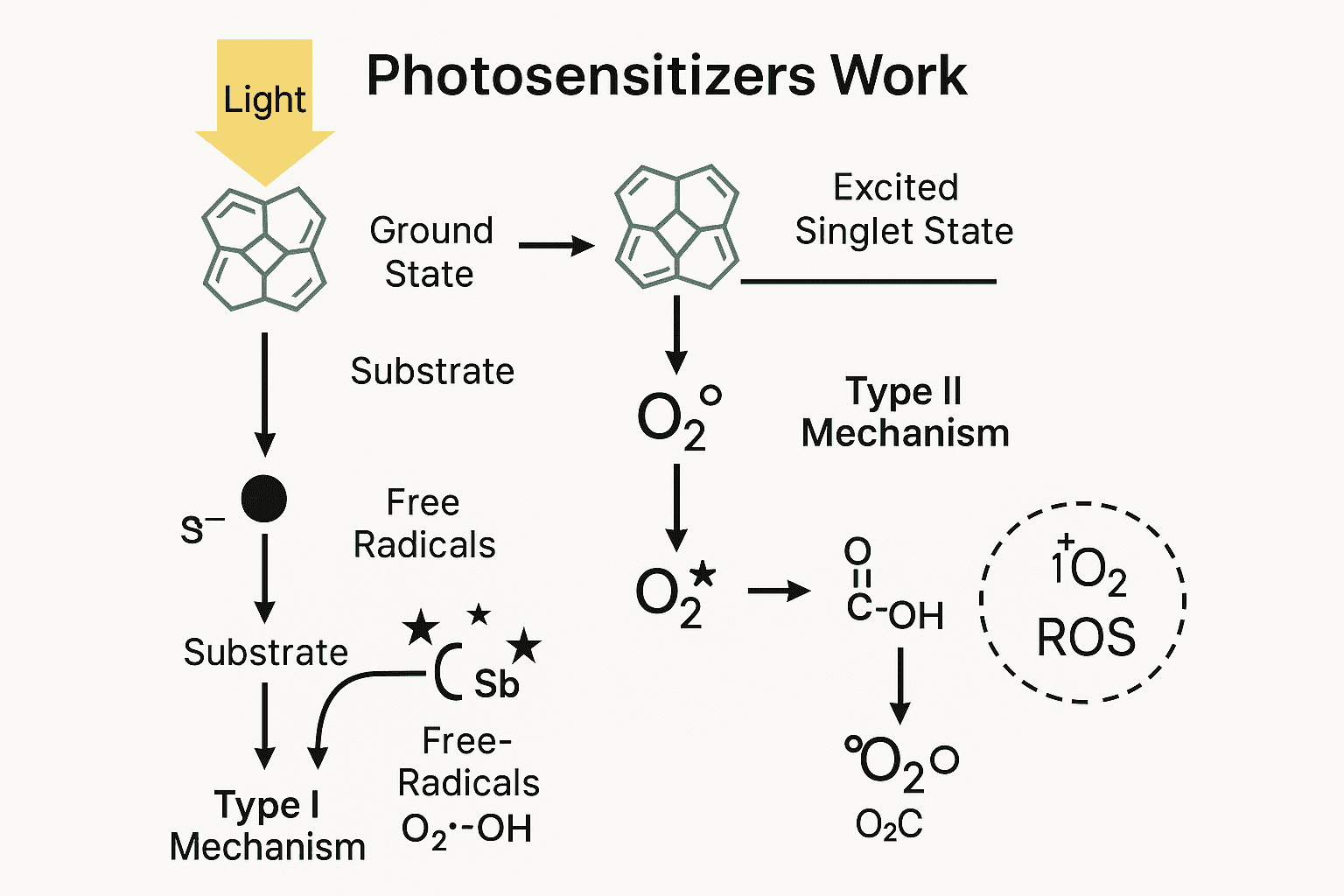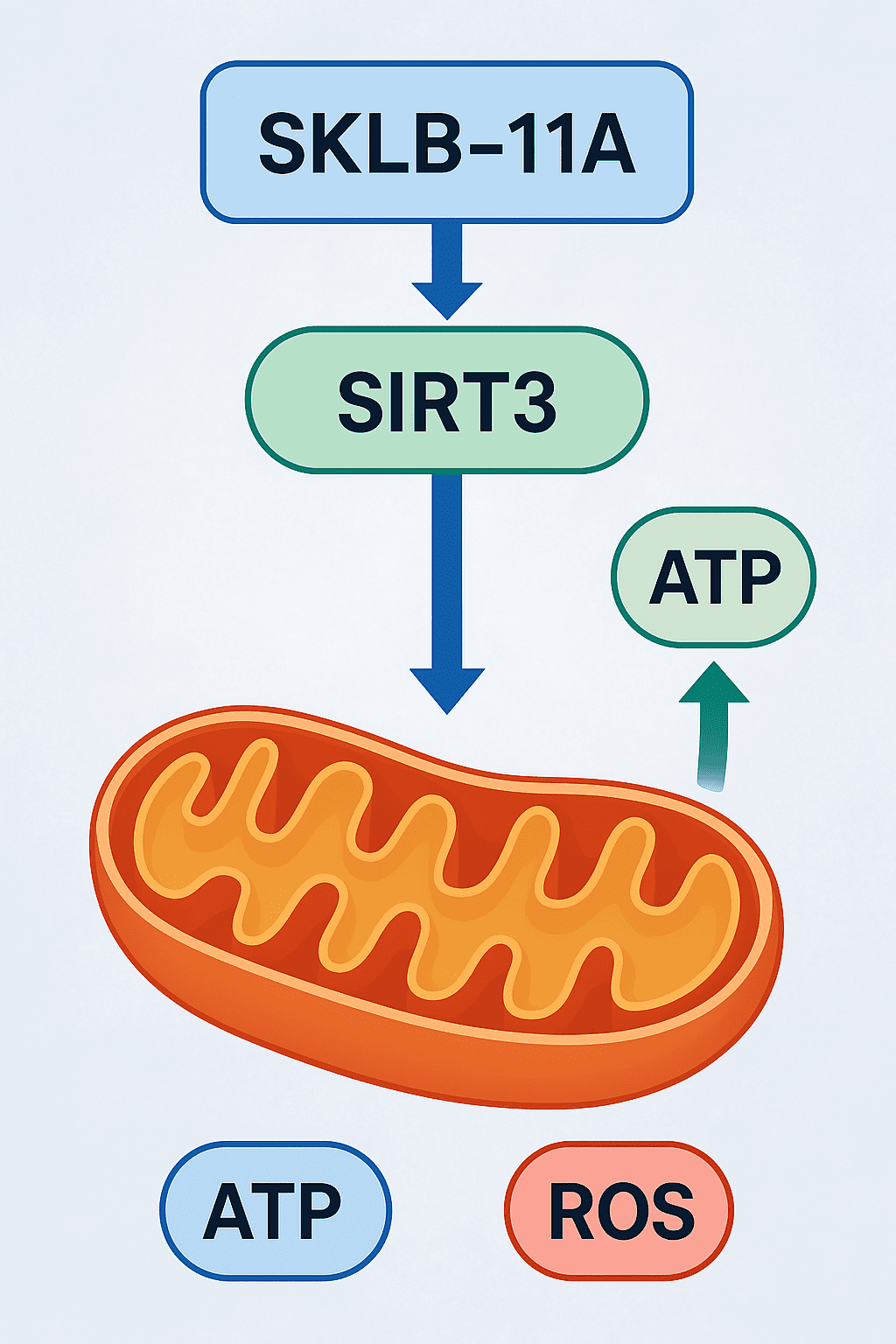Gallic Acid: The Antioxidant Powerhouse with Anticancer and Anti-Inflammatory Benefits
Abstract
Gallic acid, a naturally occurring polyphenol found in plants, fruits, and teas, offers a broad spectrum of health benefits supported by modern research. Known for its antioxidant, anti-inflammatory, antimicrobial, and anticancer properties, gallic acid is gaining recognition as a promising natural compound in preventive health and functional nutrition. It works through mechanisms that include free radical scavenging, apoptosis induction, and modulation of key cellular pathways. Abundant in everyday foods like berries, green tea, and nuts, gallic acid is both accessible and versatile. This blog explores its sources, mechanisms of action, and scientific evidence, offering practical guidance for integrating it into a health-conscious lifestyle.
Introduction: What is Gallic Acid?
Gallic acid is a naturally occurring organic compound found in a wide variety of plants, fruits, and herbs. Classified as a phenolic acid (specifically, 3,4,5-trihydroxybenzoic acid), it is one of the most studied natural polyphenols due to its wide-ranging biological properties and potential health benefits. Gallic acid occurs abundantly in foods such as green tea, grapes, berries, mangoes, walnuts, and sumac, as well as in plants like gallnuts and oak bark.
This compound has captured the interest of researchers, nutritionists, and wellness advocates alike for its antioxidant, anti-inflammatory, antimicrobial, and anticancer activities. As concerns around synthetic pharmaceuticals and chronic disease management rise, the role of plant-based compounds like gallic acid has gained significant traction.
Structurally, gallic acid contains three hydroxyl groups attached to a benzoic acid ring, which makes it highly reactive to oxidative agents, enabling it to scavenge free radicals effectively. This antioxidant potential plays a crucial role in protecting the body from cellular damage caused by oxidative stress—a major contributor to aging, cancer, and neurodegenerative diseases.
Beyond its health effects, gallic acid is also widely used in the pharmaceutical, cosmetic, and food industries as a natural preservative, due to its ability to inhibit microbial growth and delay oxidation.
In recent years, its mechanisms of action and therapeutic potential have been explored in various scientific studies, making gallic acid a prime example of how nature-derived compounds can offer safe and effective solutions to modern health challenges.
Key Health Benefits of Gallic Acid
Gallic acid is more than just a plant-based antioxidant—it’s a multi-functional compound with therapeutic relevance across several domains of human health. Its diverse pharmacological properties make it a promising candidate for both preventive and therapeutic applications.
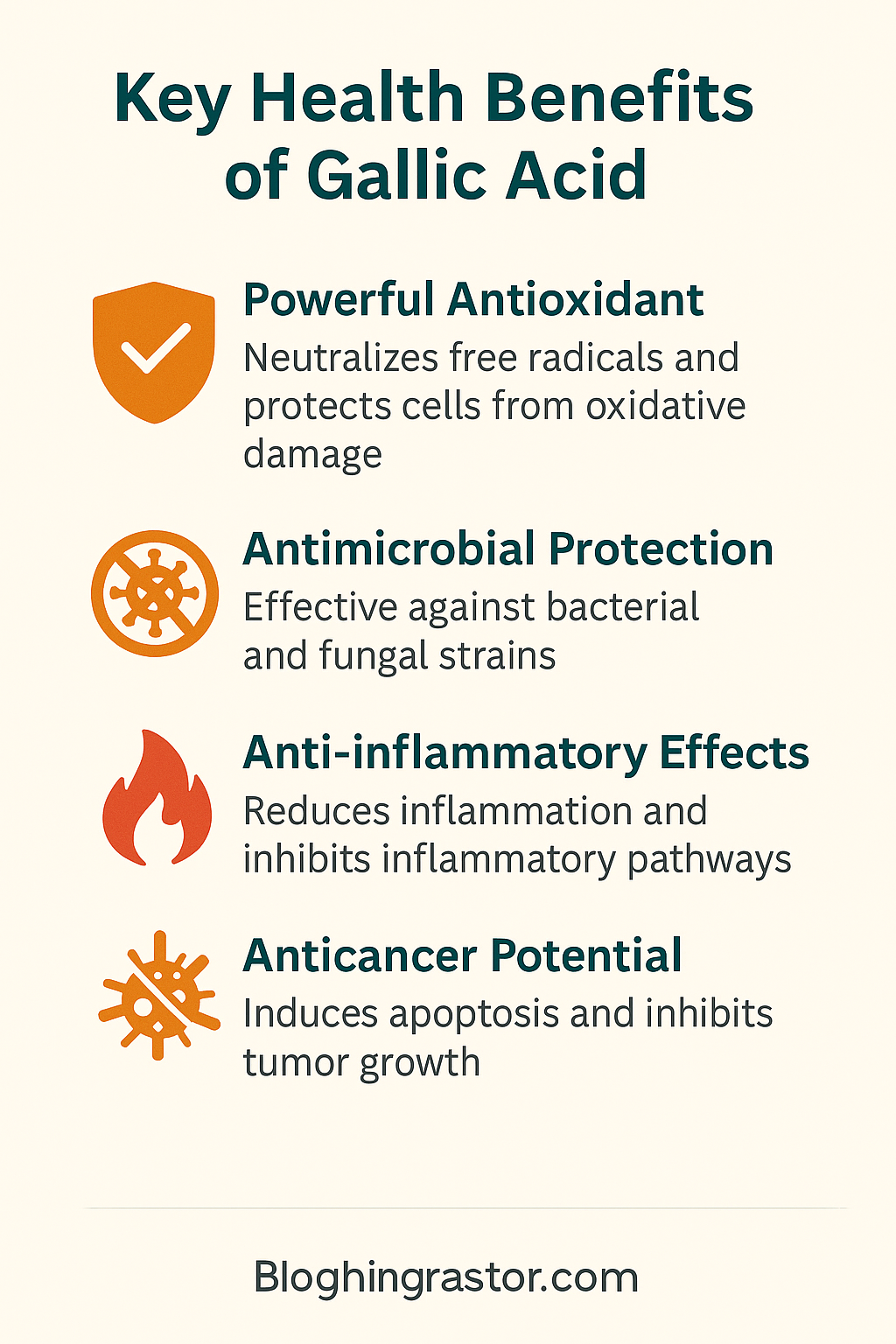
1. Powerful Antioxidant
One of gallic acid’s most significant contributions is its strong antioxidant activity. By neutralizing free radicals, it protects cells from oxidative damage—a key factor in aging, inflammation, and degenerative diseases like Alzheimer’s and Parkinson’s. Gallic acid also boosts the activity of internal antioxidant enzymes such as glutathione and catalase, further strengthening cellular defense mechanisms.
2. Antimicrobial Protection
Gallic acid has shown broad-spectrum antimicrobial properties, making it effective against various bacterial and fungal strains. It works by disrupting microbial membranes and interfering with DNA replication in pathogens, helping to control infections and food spoilage. It is also being studied as a natural food preservative.
3. Anti-inflammatory Effects
Chronic inflammation is a root cause of many diseases, including cardiovascular issues and autoimmune disorders. Gallic acid suppresses pro-inflammatory cytokines like TNF-α and IL-6, inhibiting the NF-κB signaling pathway—an essential regulator of inflammation.
4. Anticancer Potential
Perhaps the most exciting property of gallic acid is its ability to induce apoptosis in cancer cells without harming healthy ones. It can arrest tumor cell growth, inhibit angiogenesis, and suppress metastasis in cancers such as breast, lung, colon, and liver.
By targeting multiple pathways, gallic acid presents a natural, low-toxicity option for health support that aligns with the growing shift toward plant-based wellness.
How Gallic Acid Works: Mechanisms of Action
Understanding how gallic acid works at the molecular level reveals why it is so effective across various health domains. This small molecule exerts its biological effects by interacting with key cellular pathways that regulate inflammation, oxidative stress, cell survival, and microbial defense.
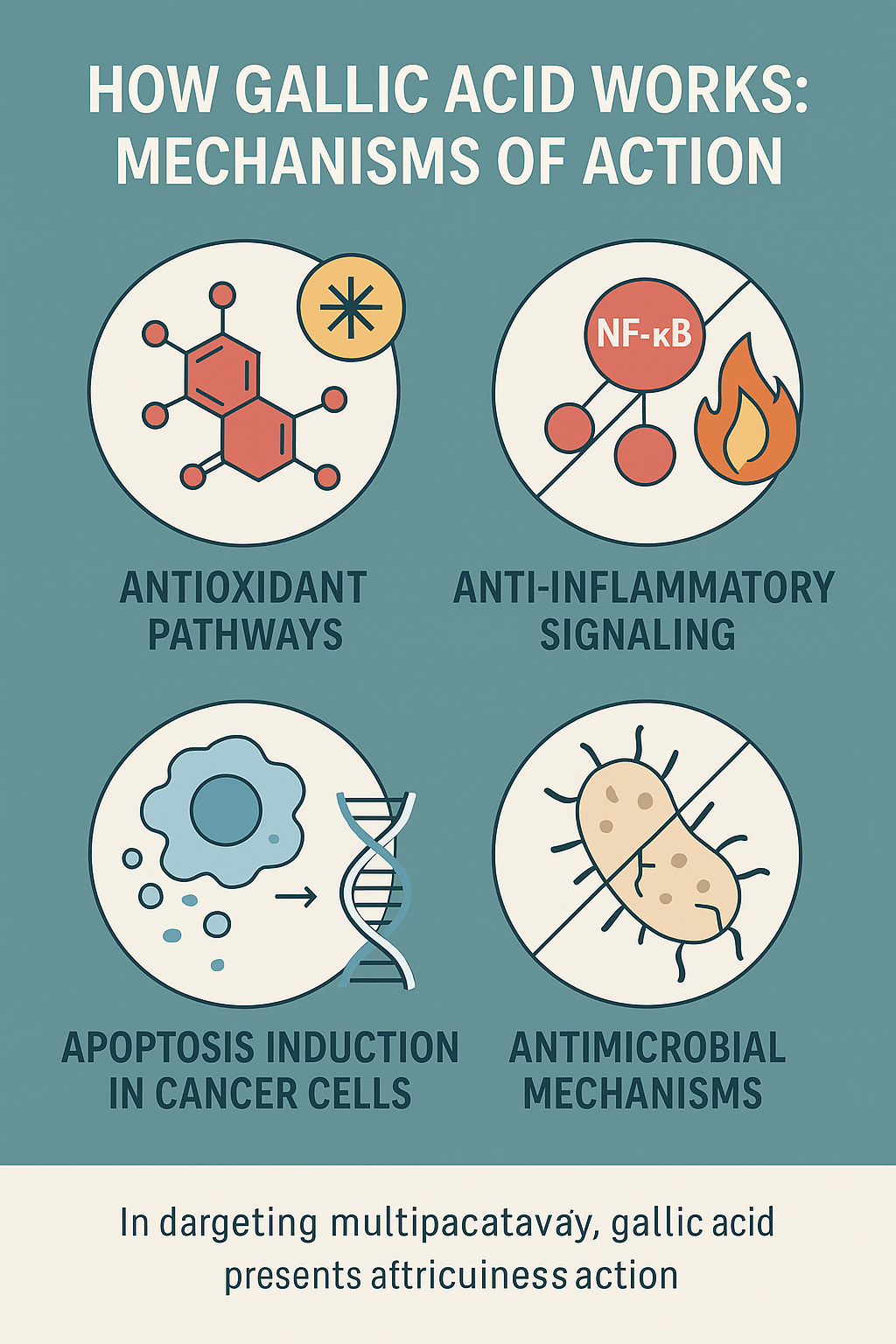
1. Antioxidant Pathways
Gallic acid acts as a free radical scavenger, neutralizing harmful molecules like reactive oxygen species (ROS) before they damage DNA, proteins, or lipids. It also stimulates the production of antioxidant enzymes such as superoxide dismutase (SOD) and glutathione peroxidase, reinforcing the body’s natural defense systems.
2. Anti-inflammatory Signaling
It inhibits the nuclear factor kappa B (NF-κB) pathway, a key driver of inflammation. By downregulating cytokines such as TNF-α, IL-1β, and IL-6, gallic acid reduces the inflammatory cascade that contributes to diseases like arthritis, diabetes, and heart disease.
3. Apoptosis Induction in Cancer Cells
In cancer therapy, gallic acid triggers programmed cell death (apoptosis) in tumor cells via both the intrinsic (mitochondrial) and extrinsic (death receptor) pathways. It activates pro-apoptotic proteins like Bax, downregulates anti-apoptotic proteins like Bcl-2, and promotes cytochrome c release, leading to cell death.
4. Antimicrobial Mechanisms
Gallic acid disrupts microbial cell walls, increases membrane permeability, and interferes with microbial DNA replication. These effects help combat pathogenic bacteria and fungi, even in antibiotic-resistant strains.
Collectively, these mechanisms explain gallic acid’s multi-target pharmacological potential, making it an attractive compound in preventive health, oncology, and drug development.
Natural Sources of Gallic Acid
Gallic acid is widely distributed in the plant kingdom and can be found in a diverse range of fruits, nuts, teas, and herbs, making it highly accessible through a regular diet. Its abundance in polyphenol-rich foods is one of the reasons it’s been closely linked to health-promoting diets like the Mediterranean and plant-based eating patterns.
1. Fruits
Several fruits are particularly rich in gallic acid, including:
Berries: Blueberries, strawberries, and blackberries are potent sources.
Grapes and Pomegranates: Especially in skins and seeds.
Bananas and Mangoes: Contain moderate levels of free-form gallic acid.
2. Beverages
Green Tea and Black Tea: Among the most studied sources due to their high content of gallic acid and its derivatives, including catechins.
Red Wine: Made from grape skins, which are rich in gallic acid.
3. Nuts and Seeds
Walnuts and Hazelnuts: Known for both their omega-3 content and phenolic richness, including gallic acid.
4. Herbs and Spices
Sumac and Clove: These spices top the list in gallic acid concentration.
Oak bark and gallnuts: Traditionally used in herbal medicine due to their astringent and antimicrobial qualities.
5. Functional Foods and Extracts
Gallic acid is also available as dietary supplements or incorporated into fortified foods and nutraceuticals, often in the form of extracts from gallnuts or grape seeds.
Including these foods in your diet not only supports antioxidant and anti-inflammatory balance but may also reduce the risk of chronic disease.
Clinical Research and Scientific Evidence on Gallic Acid
Over the past two decades, gallic acid (GA) has garnered increasing scientific attention for its multi-target pharmacological effects. A growing body of in vitro, in vivo, and preclinical studies demonstrates its therapeutic potential across cancer, infection, cardiovascular, and metabolic disorders.
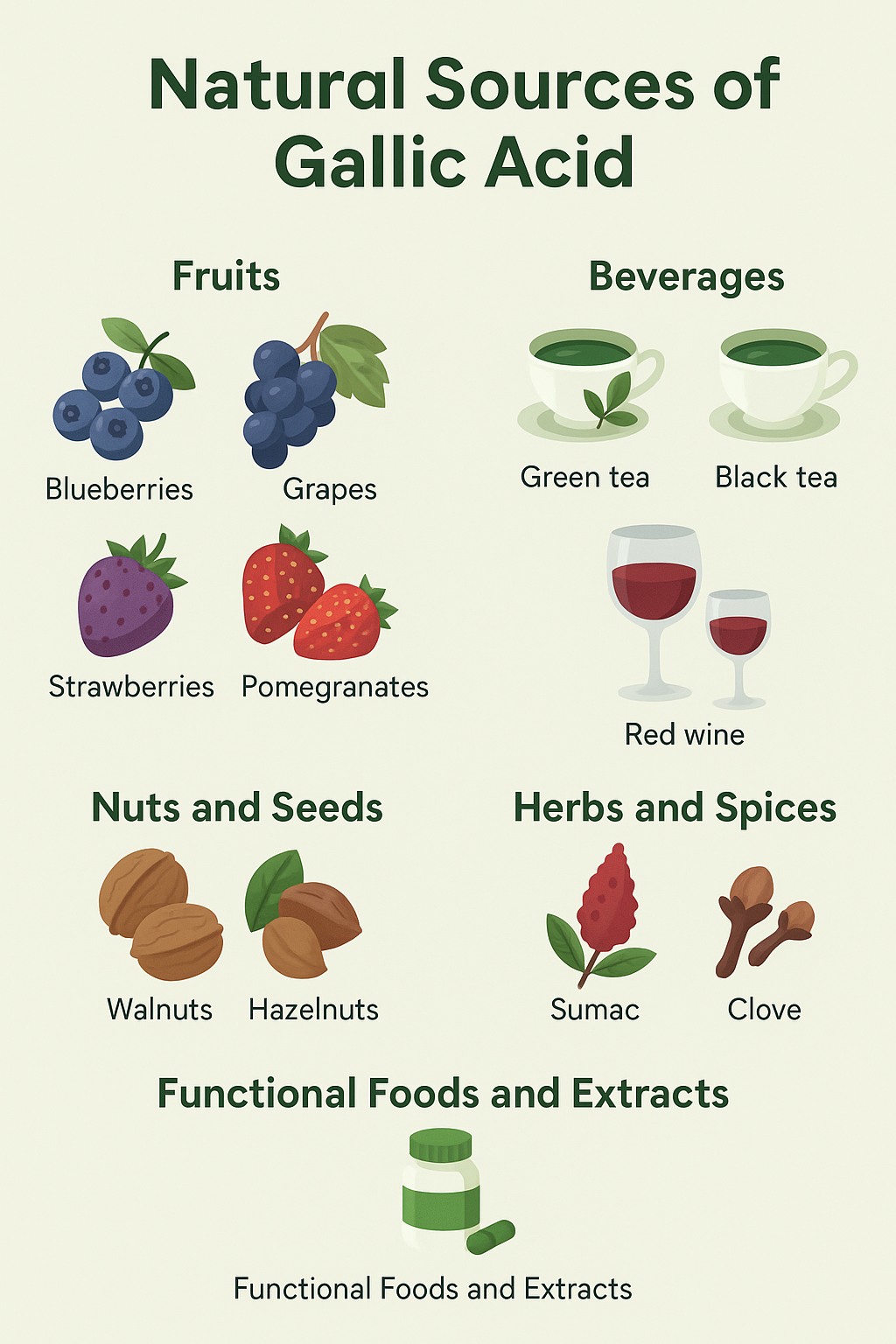
1. Anticancer Studies
Numerous studies confirm gallic acid’s ability to induce apoptosis in cancer cells without damaging normal cells. For example, gallic acid has shown efficacy in inhibiting the growth of lung, breast, colon, and liver cancers. Its mechanisms include DNA fragmentation, reactive oxygen species generation, and downregulation of Bcl-2 expression.
In glioma and breast cancer models, GA enhanced the effectiveness of chemotherapy agents like temozolomide and cisplatin, making it a promising adjuvant candidate.
2. Anti-inflammatory and Antioxidant Action
Clinical trials and animal models show that gallic acid significantly reduces levels of C-reactive protein, TNF-α, and IL-6, markers of chronic inflammation. It also improves antioxidant capacity by increasing glutathione and superoxide dismutase activity.
3. Gut Health and Immune Regulation
Recent studies focus on GA’s gut microbiome-modulating effects, suggesting it promotes beneficial bacteria while suppressing pathogens, potentially enhancing immunity and reducing gut-driven inflammation.
4. Pharmaceutical Formulations
Emerging drug-delivery research explores nanoencapsulation of gallic acid, which improves its bioavailability and targeting, particularly for skin diseases, cancer therapy, and transdermal systems.
Despite strong preclinical data, human clinical trials remain limited, underscoring the need for translational research.
Conclusion: Should You Include Gallic Acid in Your Lifestyle?
As modern wellness trends increasingly embrace plant-based, functional ingredients, gallic acid stands out as a scientifically supported, natural compound with impressive health potential. From preventing chronic inflammation to fighting oxidative stress and aiding in the fight against cancer, the evidence is compelling.
Gallic acid offers a low-toxicity, multi-target solution to many of the health issues linked to oxidative damage, microbial infections, and unregulated inflammation. Its antioxidant and anticancer actions, coupled with its presence in everyday foods like green tea, berries, and walnuts, make it both accessible and practical.
For those interested in preventative health, including gallic acid-rich foods in your diet is a simple and effective strategy. Whether it’s a cup of green tea, a serving of berries, or a handful of walnuts, these everyday choices can contribute to your long-term wellness. Additionally, if you are exploring natural supplements, look for formulations standardized to contain gallic acid or derived from sources like gallnut or grape seed extract.
That said, while preclinical studies are robust, human clinical trials are still emerging. This means that although the biological plausibility is strong, recommendations for therapeutic use should be made with caution and under professional guidance, especially for those with chronic conditions or on medication.
In summary, gallic acid is more than a nutritional buzzword—it’s a bioactive powerhouse with diverse benefits for the mind and body. Whether you’re a health-conscious consumer or a functional nutrition enthusiast, gallic acid deserves a place in your lifestyle.
References
Kahkeshani, N., Farzaei, F., Fotouhi, M., Alavi, S. S., Bahramsoltani, R., Naseri, R., … & Bishayee, A. (2019). Pharmacological effects of gallic acid in health and diseases: A mechanistic review. Iranian Journal of Basic Medical Sciences, 22(3), 225–237.
https://pmc.ncbi.nlm.nih.gov/articles/PMC6528712/
Zhang, J., Li, L., Kim, S. H., Hagerman, A. E., & Lü, J. (2009). Anti-cancer, anti-diabetic and other pharmacologic and biological activities of penta-galloyl-glucose. Pharmaceutical Research, 26(9), 2066–2080.
https://link.springer.com/article/10.1007/s11095-009-9932-0
Hadidi, M., Liñán-Atero, R., Tarahi, M., & Christodoulou, M. C. (2024). The potential health benefits of gallic acid: Therapeutic and food applications. Antioxidants, 13(8), 1001.
https://www.mdpi.com/2076-3921/13/8/1001
Hong, R., Lim, S. C., Lee, T. B., & Han, S. I. (2023). Anticancer effect of gallic acid on acidity-induced invasion of MCF7 breast cancer cells. Nutrients, 15(16), 3596.
https://www.mdpi.com/2072-6643/15/16/3596
Badhani, B., Sharma, N., & Kakkar, R. (2015). Gallic acid: A versatile antioxidant with promising therapeutic and industrial applications. RSC Advances, 5(35), 27540–27557.
https://pubs.rsc.org/en/content/articlehtml/2015/ra/c5ra01911g
Khorsandi, K., Kianmehr, Z., Hosseinmardi, Z., & Alizadeh, F. (2020). Anti-cancer effect of gallic acid in presence of low-level laser irradiation: ROS production and induction of apoptosis and ferroptosis. Cancer Cell International, 20, 1–11.
https://link.springer.com/article/10.1186/s12935-020-1100-y
Subramanian, A. P., John, A. A., Vellayappan, M. V., Balaji, A., & Jaganathan, S. K. (2015). Gallic acid: Prospects and molecular mechanisms of its anticancer activity. RSC Advances, 5(46), 35608–35621.
https://pubs.rsc.org/en/content/articlehtml/2003/0v/c5ra02727f
Keyvani‐Ghamsari, S., & Rahimi, M. (2023). An update on the potential mechanism of gallic acid as an antibacterial and anticancer agent. Food Science & Nutrition, 11(15), 3523–3537.
https://onlinelibrary.wiley.com/doi/full/10.1002/fsn3.3615
Kumar, N., & Goel, N. (2019). Phenolic acids: Natural versatile molecules with promising therapeutic applications. Biotechnology Reports, 24, e00370.
https://www.sciencedirect.com/science/article/pii/S2215017X19302383
Lee, J. T., Yang, J. T., Chen, C. H., Lu, F. J., Chung, C. Y., & Lee, M. H. (2022). Gallic acid enhances the anti-cancer effect of temozolomide in human glioma cell line via inhibition of Akt and p38-MAPK pathway. Processes, 10(3), 448.
https://www.mdpi.com/2227-9717/10/3/448
Aldawsari, M. F., Alkholifi, F. K., Foudah, A. I., Alqarni, M. H., & Yusufoglu, H. S. (2023). Gallic-acid-loaded PLGA nanoparticles: A promising transdermal drug delivery system with antioxidant and antimicrobial agents. Pharmaceuticals, 16(8), 1090.


